
Savannah is the oldest city in the U.S. state of Georgia and is the county seat of Chatham County. Established in 1733 on the Savannah River, the city of Savannah became the British colonial capital of the Province of Georgia and later the first state capital of Georgia. A strategic port city in the American Revolution and during the American Civil War, Savannah is today an industrial center and an important Atlantic seaport. It is Georgia's fifth-largest city, with a 2020 U.S. Census population of 147,780. The Savannah metropolitan area, Georgia's third-largest, had a 2020 population of 404,798.

Chatham County is located in the U.S. state of Georgia, on the state's Atlantic coast. The county seat and largest city is Savannah. One of the original counties of Georgia, Chatham County was created February 5, 1777, and is named after William Pitt, 1st Earl of Chatham.
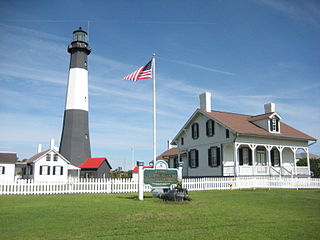
Tybee Island is a city and a barrier island located in Chatham County, Georgia, 18 miles (29 km) east of Savannah, United States. Though the name "Tybee Island" is used for both the island and the city, geographically they are not identical: only part of the island's territory lies within the city.
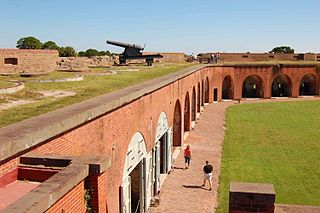
Fort Pulaski National Monument is located on Cockspur Island between Savannah and Tybee Island, Georgia. It preserves Fort Pulaski; during the American Civil War, the Union Army successfully tested rifled cannon in combat in 1862 there, the success of which rendered brick fortifications obsolete. The fort was also used as a prisoner-of-war camp.

The siege of Fort Pulaski concluded with the Battle of Fort Pulaski fought April 10–11, 1862, during the American Civil War. Union forces on Tybee Island and naval operations conducted a 112-day siege, then captured the Confederate-held Fort Pulaski after a 30-hour bombardment. The siege and battle are important for innovative use of rifled guns which made existing coastal defenses obsolete. The Union initiated large-scale amphibious operations under fire.

Florence Margaret Martus, also known as "the Waving Girl", took it upon herself to be the unofficial greeter of all ships that entered and left the Port of Savannah, Georgia, between 1887 and 1931. A few years after she began waving at passing sailors, she moved in with her brother, a light keeper, at his small white cottage about five miles up the river from Fort Pulaski. From her rustic home on Elba Island, a tiny piece of land in the Savannah River near the Atlantic Ocean, Martus would wave a handkerchief by day and a lantern by night. According to legend, not a ship was missed in her forty-four years on watch. A statue of Martus by the sculptor Felix de Weldon has been erected in Morrell Park on the historic riverfront of Savannah.

Cockspur Island is an island in the south channel of the Savannah River near Lazaretto Creek, northwest of Tybee Island, Georgia, United States. Most of the island is within the boundaries of Fort Pulaski National Monument. The island was so named on account of its bent shape. It was originally called Pepper Island and is also called Long Island.
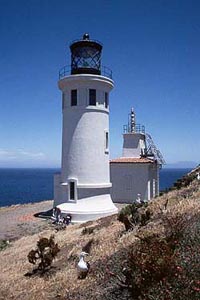
Anacapa Island Lighthouse is a lighthouse in California, United States, on the entrance to Santa Barbara Channel, California. Constructed in 1912, it was the last major light station built on the west coast. Anacapa and several other islands were collectively designated as Channel Islands National Monument in 1938, though the Coast Guard retained responsibility for the Anacapa lighthouse. Now fully automated and unmanned, the light house still operates, but the National Park Service (NPS) is responsible for Channel Islands National Park.

Sapelo Island Lighthouse is a lighthouse in Georgia, United States, near the southern tip of Sapelo Island. It is the nation's second-oldest brick lighthouse and the oldest survivor among lighthouses designed by Winslow Lewis. The lighthouse, oil building, the cistern, the footing of the 1905 light, the ruins of the fortification, and the associated range light were added to the National Register of Historic Places in 1997.
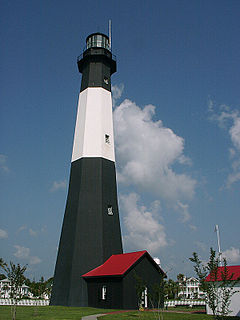
Tybee Island Light is a lighthouse next to the Savannah River Entrance, on the northeast end of Tybee Island, Georgia. It is one of seven surviving colonial era lighthouse towers, though highly modified in the mid 1800s.

Patrick Henry "Paddy" O'Rorke or O'Rourke was an Irish-American immigrant who became a colonel in the Union Army during the American Civil War and was killed at the Battle of Gettysburg.

The protected areas of Georgia cover almost one million acres (4,000 km2) of the state. These areas are managed by different federal and state level authorities and receive varying levels of protection. Some areas are managed as wilderness while others are operated with acceptable commercial exploitation. On the Federal level, Georgia contains 1 Biosphere Reserve, 15 National Park Service Managed Sites, 1 National Forest and 8 Wildlife Refuges. Georgia is home to 63 state parks, 48 of which are state parks and 15 that are National Historic Sites, and many state wildlife preserves, under the supervision of the Georgia Department of Parks and Recreation, a division of the Georgia Department of Natural Resources.

Fort James Jackson is a restored nineteenth-century fort located one mile east of Savannah, Georgia, on the Savannah River. It hosts the Fort Jackson Maritime Museum.

The Fort Sumter Range Lights are range lights to guide ships through the main channel of the Charleston Harbor, South Carolina. The original front light was built at Fort Sumter and the original rear light was in the steeple of St. Philip's Church in Charleston, South Carolina. Both lights were lit from 1893 to 1915 to make range lights. Today the Fort Sumter Range is the main approach channel to Charleston Harbor.

Ship Island Light was a lighthouse in Mississippi near Gulfport.

The Clarks Point Light is located in New Bedford, Massachusetts. Originally constructed as a wooden tower, it was replaced with a stone tower in 1804. This in turn was replaced by a structure on the parapets of Fort Rodman which was deactivated in 1898. After restoration in the early 1970s, it was relit again in 2001 by the city as a private aid.

The Old Harbor Light, which is also known as the Savannah Harbor Rear Range Light or the Beacon Range Light, is a former aid to navigation in Emmet Park on East Bay Street in Savannah, Georgia. The light has the appearance of a giant street light. It is within the boundaries of Savannah Historic District and was erected by the federal government in 1858, contemporary with most of the structures in the district.
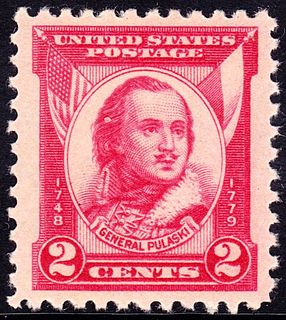
Casimir Pulaski was a Polish nobleman, soldier and military commander who has been called "the father of the American cavalry". He has had hundreds of monuments, memorial plaques, streets, parks and similar objects named after him.
Department of Key West, was a military department of the Union Army created in February 1862 from the Department of Florida. It had command over the posts that were newly captured by “Expeditionary Corps” combined of Army and Navy units under Brigadier General Thomas W. Sherman and Flag Officer Samuel Francis Du Pont. These were posts at Fernandina, St. Augustine and the forces investing Fort Pulaski and blockading the Savannah River on Tybee Island at the mouth of the river.





















